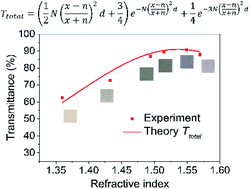Refractive index of delignified wood for transparent biocomposites
Abstract
Refractive index (RI) determination for delignified wood templates is vital for transparent wood composite fabrication. Reported RIs in the literature are based on either single plant fibers or wood powder, measured by the immersion liquid method (ILM) combined with mathematical fitting. However, wood structure complexity and the physical background of the fitting were not considered. In this work, RIs of delignified wood templates were measured by the ILM combined with a light transmission model developed from the Fresnel reflection/refraction theory for composite materials. The RIs of delignified balsa wood are 1.536 ± 0.006 and 1.525 ± 0.008 at the wavelength of 589 nm for light propagating perpendicular and parallel to the wood fiber direction, respectively. For delignified birch wood, corresponding values are 1.537 ± 0.005 and 1.529 ± 0.006, respectively. The RI data for delignified wood scaffolds are important for tailoring optical properties of transparent wood biocomposites, and also vital in optical properties investigations by theoretical modelling of complex light propagation in transparent wood and related composites. The developed light transmission model in combination with the immersion liquid method can be used to determine the RI of complex porous or layered solid materials and composites.



 Please wait while we load your content...
Please wait while we load your content...